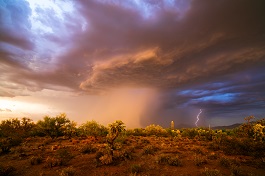
Monsoon weather is here, and the Arizona Game and Fish Department (AZGFD) cautions boaters and off-highway vehicle (OHV) users that weather conditions can quickly change and become dangerous for those who aren’t prepared.
The severity of monsoon storms varies greatly from a minor dust storm to a violent thunderstorm capable of producing hail, deadly lightning and flash flooding.
“Arizona is known for its often unbearable summer heat; it’s also known for great places to get outdoors, whether that’s on an OHV in the high country or one of our many lakes or rivers,” said Josh Hoffman, boating safety education coordinator.
“However, it’s important for people to keep the day’s weather in mind. If severe weather is likely, or storms are starting to build up around you, it’s a good time to safely get off the water or trails and head indoors.”
Paddlers who enjoy the water on a paddleboard should pay extra close attention to the weather. “In previous years most boaters caught in monsoon weather were paddlers,” Hoffman said.
AZGFD offers the following advice to protect those recreating during a monsoon:
When On A Boat, Personal Watercraft Or Paddleboard
- While life jackets are legally required for anyone under 12, everyone should wear a life jacket at all times while on the water. Storms can create large waves that could knock a passenger from the boat.
- Monitor the weather and use a weather radio or a weather app for updates from the National Weather Service. If storms are predicted, or are approaching, pull the boat out of the water or consider postponing the outing.
- Secure all gear above and below decks.
- Keep everyone aboard away from electrical and ungrounded components, and remain as low in the boat as possible.
- If there is lightning, disconnect all electrical equipment. Stay clear of metal objects as much as possible.
- Slow down, but keep enough power to maintain headway and steering.
- Turn on navigation lights.
- If possible, head for the nearest shore that is safe to approach. It might be best to ride out the storm in open water rather than try to approach the shore in heavy wind and waves.
- Boats should head the bow into waves at a 45-degree angle. Personal watercrafts should head directly into the waves.
For more information on boating in Arizona, visit www.azgfd.com/Boating/.
When Riding An OHV
- Always wear proper safety gear, including a helmet, eye protection, long sleeves, pants, over-the-ankle boots and gloves.
- Seek shelter indoors if storms are developing or are nearby.
- Never cross running water. While it can look shallow, it might be deep enough that it could push the vehicle downstream or get it stuck in loose sediment.
- Drive slowly to not lose control on muddied trails.
- To avoid being struck by lightning, avoid open fields, high ground, trees, poles or other tall objects, and standing bodies of water.
- Be aware of, and avoid, flash flood zones.
For more information on riding an OHV in Arizona, visit www.azgfd.com/OHV/































